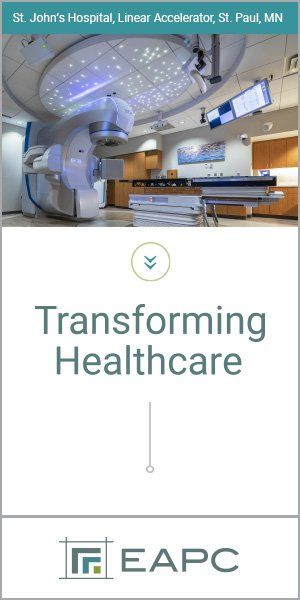esigning health care facilities to be accessible for individuals with disabilities requires addressing a complex intersection of technology, patient needs and architectural constraints. While federal regulations such as the Americans with Disabilities Act (ADA) provide essential guidelines for general accessibility, diagnostic equipment often falls outside these frameworks, creating significant challenges for equitable patient care. For instance, a 2021 report by the National Council on Disability revealed that fewer than 10% of medical diagnostic equipment such as MRI machines and mammography units are fully accessible to individuals with disabilities, highlighting the pressing need for inclusive design solutions.
Health Care Architecture
Designing for Dignity and Equality
New ADA Guidelines for Health Care Facilities
BY Dan Abeln, AIAG
A fundamental issue lies in the inherent design of diagnostic equipment, which frequently demands physical dexterity or endurance that some patients may lack. Raised imaging tables, confined spaces in MRI machines or requirements to remain motionless can prove nearly impossible for individuals with mobility challenges, chronic pain or muscle weakness. According to the U.S. Department of Health and Human Services, nearly 13.7% of adults in the U.S. have a mobility disability, underscoring the widespread impact of inaccessible diagnostic equipment. Patients with visual or hearing impairments encounter additional barriers when instructions are delivered exclusively through auditory or visual means. Neurodivergent patients, including those with autism, often face heightened stress due to the sensory demands of bright lights, loud noises and unfamiliar environments. The CDC estimates that 1 in 36 children in the United States has been identified with autism spectrum disorder, making sensory-inclusive design a growing priority in health care.
Fewer than 10% of medical diagnostic equipment such as MRI machines and mammography units are fully accessible to individuals with disabilities.
Design Challenges
Architects tasked with designing health care spaces must confront these challenges head-on while balancing the practical demands of technology and the needs of diverse patient populations. One significant hurdle is the space required to house advanced diagnostic equipment, which must be installed, operated and maintained in compliance with rigorous technical standards. These machines often demand spacious rooms with specialized layouts, and designers must also ensure that the surrounding areas allow for smooth patient flow and adequate maneuverability for wheelchairs, stretchers and other mobility aids. The need to optimize space while accommodating the large footprints of equipment can strain even the most carefully planned facility. For example, MRI machines typically require a minimum of 325 square feet, not including control rooms and associated infrastructure, placing significant demands on available space.
The layout and placement of diagnostic equipment within a facility play a critical role in accessibility. Poorly designed workflows can create bottlenecks, particularly for patients using assistive devices or needing staff assistance. Architects must thoughtfully position these areas in relation to waiting rooms, restrooms and other patient services to ensure ease of access without compromising operational efficiency. Simultaneously, designers must address the ergonomic needs of diagnostic spaces, integrating elements like height-adjustable tables, grab bars and lift systems to enhance usability. However, incorporating these features often requires close collaboration with equipment manufacturers, as retrofitting technology after installation can be both costly and inefficient.
Further Complications
Patients often bring their own assistive devices, such as wheelchairs or walkers, which further complicates the design of diagnostic spaces. Designers must ensure adequate turning radii, clear pathways and storage solutions for these devices without disrupting the primary function of the room. Additionally, medical facilities increasingly accommodate service animals, necessitating thoughtful design features such as resting areas and unobstructed floor plans. The Rehabilitation Engineering Research Center reports that 70% of people with disabilities who use assistive devices encounter barriers in health care environments, emphasizing the importance of addressing these challenges during the design phase.
In our rural health care projects, the focus on accessibility has been particularly significant, with an emphasis on improving the design of patient pathways. Retrofitting doors to accommodate larger wheelchairs has become a priority to ensure smooth access for patients of size. Furthermore, the installation of wide-bore CT imaging equipment has been instrumental in mitigating issues of claustrophobia and enhancing comfort for patients of diverse body types. These upgrades not only improved the patient experience but also demonstrated how thoughtful design can address both the physical and emotional challenges faced by patients during diagnostic procedures. Such concerns highlight the importance of integrating advanced technology with accessible design principles to create a more dignified and inclusive health care environment.
Universal design principles offer a valuable framework for addressing these challenges, emphasizing the creation of spaces that are usable by all individuals, regardless of ability. Features like tactile and visual wayfinding, low-sensory environments for patients who are easily overstimulated, and flexible room configurations that can adapt to diverse needs are critical components of truly inclusive environments. Integrating these principles requires early collaboration among architects, providers and individuals with disabilities. Stakeholders’ input during the design phase, combined with the use of mock-ups or simulations, can help identify potential barriers and refine solutions before construction begins.
Manufacturers of diagnostic equipment are also contributing to improved accessibility through adaptive technologies. Many imaging tables now feature automatic lift systems, side access panels and other modifications designed for patients with mobility challenges. Architects play an important role in advocating for these innovations during procurement discussions, ensuring that the equipment aligns with the broader goal of accessibility. Designing for accessibility, however, must also consider the future, as technology continues to evolve. Modular layouts and reconfigurable spaces allow facilities to adapt to new equipment and changing patient needs without requiring extensive renovations.
In a recent project for Twin Cities Spine, a series of accessibility-focused upgrades were implemented to improve patient comfort and streamline diagnostic procedures. One notable enhancement was the installation of full-length radiation protection panels, which enabled imaging of the spine and hips from a single standing position. This advancement eliminated the need for repositioning patients, significantly reducing discomfort for individuals with mobility challenges. Additionally, patient lifts were incorporated to facilitate the safe and efficient transfer of patients onto imaging equipment. These lifts were complemented by height-adjustable tables and models capable of supporting increased weight capacities of up to 600 and 900 pounds, ensuring inclusivity for a broader range of patient sizes.
13.7% of adults in the United States have a mobility disability. 70% of people with disabilities who use assistive devices encounter barriers in health care environments.
Addressing Space Constraints: The Case for Accessible Weight Scales
One of the most overlooked yet essential components of accessible care is the availability of weight scales that accommodate individuals with disabilities. Standard clinic scales often pose challenges for patients using wheelchairs or other mobility aids, making it difficult for providers to obtain accurate weight measurements—a critical factor in diagnostics, treatment planning and medication dosing.
Despite the growing recognition of this issue, space constraints frequently hinder the integration of accessible scales. A notable example is North Memorial’s downtown clinic, which initially planned to install an accessible weight scale but ultimately abandoned the effort due to a lack of available space. This dilemma is not uncommon in medical facilities, where limited square footage often forces administrators to prioritize larger diagnostic equipment over accessibility-enhancing features.
However, the inclusion of accessible weight scales is not just a convenience—it is a necessity. For general clinics, hospitals and specialty providers, ensuring that all patients can be weighed accurately is fundamental to equitable care. Without such accommodations, patients with disabilities may face misdiagnoses, improper medication dosages or the burden of seeking alternative facilities with accessible equipment.
Architects and health care planners must take these considerations into account, ensuring that facilities allocate space for accessible weight scales from the outset. By integrating these features into initial design plans, health care environments can avoid the pitfalls of retrofitting while fostering a truly inclusive care experience.
In Minnesota, where health care providers and stakeholders are known for their innovation and patient-centered care, thoughtfully designed spaces have the potential to set a national example for accessibility. Architects and health care providers alike must embrace the opportunity to transform diagnostic spaces into environments where every patient can feel respected and accommodated, advancing the mission of equitable care across the health care continuum.
Ultimately, creating accessible diagnostic environments reflects a commitment to patient equity and dignity. The World Health Organization estimates that over one billion people, or approximately 15% of the global population, live with some form of disability. In the U.S., the Census Bureau reports that approximately 26% of adults have a disability, making accessibility in health care not just a matter of compliance but an ethical imperative. By addressing the physical, sensory and logistical barriers inherent in diagnostic spaces, facilities can provide a more inclusive experience for all patients, ensuring that individuals with disabilities receive the same standard of care as their peers.
Advancing Accessibility in Diagnostic Equipment
In a significant move toward ensuring equitable health care access, the U.S. Department of Justice has implemented a new rule under Title II of the Americans with Disabilities Act (ADA) aimed at significantly increasing the availability of accessible medical diagnostic equipment. Effective as of October 8, 2024, this regulation requires certain hospitals and health care clinics to comply with technical standards for exam tables, weight scales and other diagnostic tools, addressing long-standing accessibility gaps. The rule’s implementation, which coincided with the 34th anniversary of the ADA, underscores the federal commitment to eliminating barriers that prevent people with disabilities from receiving essential medical care.
“Thirty-four years after passage of the ADA, people with disabilities should not have to forgo needed medical care due to inaccessible medical diagnostic equipment,” stated Assistant Attorney General Kristen Clarke of the Justice Department’s Civil Rights Division. “This rule marks a significant milestone in our ongoing efforts to ensure that people with disabilities can get the medical treatment they need.”
The new regulation was introduced in response to numerous complaints from individuals with disabilities who had been denied basic medical services due to a lack of accessible equipment. The Justice Department cited instances where patients were unable to receive adequate physical exams, dental care, mammograms and other preventive services simply because they could not be transferred from their wheelchairs to exam tables. To address these disparities, the rule mandates that public hospitals and health clinics — including entities contracted by state and local governments — adopt standards initially set by the U.S. Access Board in 2017.
Key provisions of the rule include prohibiting health care providers from denying services to patients with disabilities due to inaccessible equipment; requiring the acquisition of accessible diagnostic tools; and mandating that staff assist patients with transfers and positioning. Additionally, the regulation requires all providers using exam tables and weight scales to have at least one accessible version of the equipment by August 9, 2026. By setting these standards, the Justice Department aims to bridge the accessibility gap in health care diagnostics, ensuring that people with disabilities can receive comprehensive medical care without undue burden.
This development not only aligns with the principles of universal design but also reinforces the ethical imperative of accessibility in health care environments. As health care facilities and architects work to incorporate these standards, the move signals a broader shift toward designing spaces that uphold patient dignity and equity.
Dan Abeln, AIA, is principal and director of health care at EAPC Architects Engineers.
MORE STORIES IN THIS ISSUE
cover story one
Volatile Organic Compounds: A beacon of hope
By David R. Brown, MD, DSc, Bradley S. Miller, MD, PhD and Andre Lamontagne, BEE, MBA
cover story two
The Future of Biomedical Research: A new presidential advisory from the American Heart Association






































